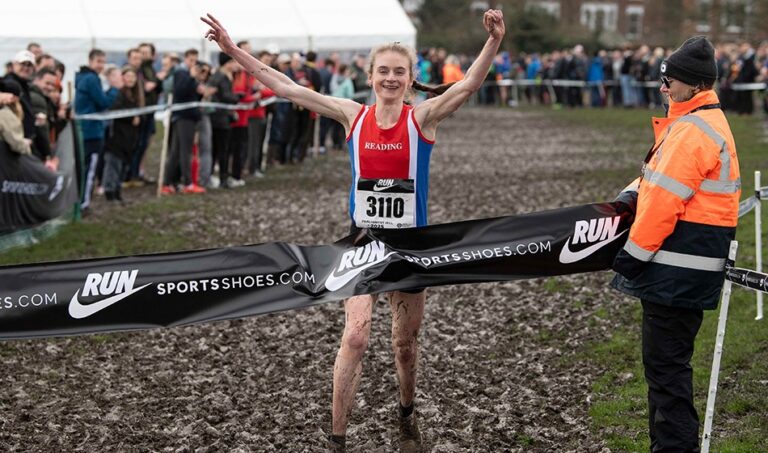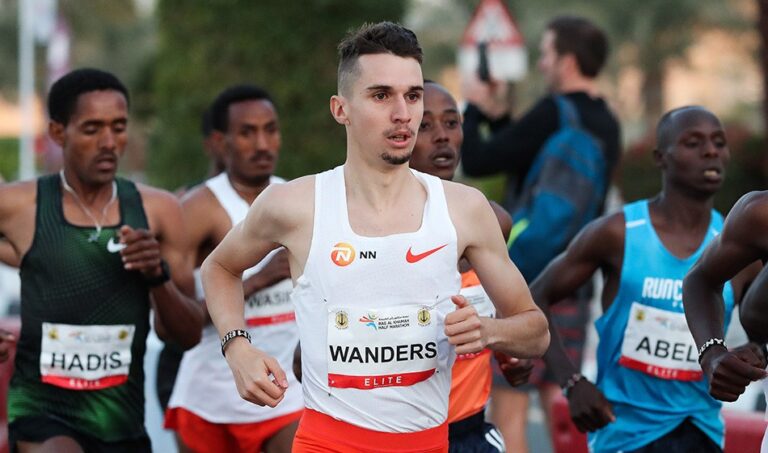
Katy Barden pays a visit to an ultra runner who made history by completing the notorious Barkley Marathons – and did so while juggling a young family and a full-time job
“I thought it was you, I saw you on the news!” exclaims the postman as he hands a parcel to Jasmin Paris. He’s keen to chat to her about her latest achievement, but the working mum-of-two looks slightly bemused. They talk briefly about her neighbours and her dog, Moss, before he takes his leave, and his claim to fame, to the next stop on his round.
Jasmin Paris
It’s mid-April and just over three weeks since Paris made history, completing the final loop of the Barkley Marathons and touching the famous yellow gate for the fifth time – the first woman to do so – before collapsing with exhaustion.
She has invited AW into her rural home to the south of Edinburgh to reflect on her experience and in particular to talk about the training it took to get to, and through, the ultra-marathon trail race known for its extreme difficulty and many peculiarities.
Since 1989 (when the original course was extended) more than 1000 competitors have attempted it, but only 20 have ever finished the 100-mile route which includes about 16,500m (54,000 feet) of elevation – the equivalent of climbing Mount Everest twice – within the 60-hour time limit.
In 2022, following her first Barkley Marathons where she completed a “Fun Run” of three loops, Paris published an extract from her application essay on her blog: “I’m looking for a new challenge, an adventure that will push me to the limits of what I can endure, and beyond. I’m ready to feel small and insignificant in the wilderness, and I’m excited to find out what I can achieve, when I believe in the impossible.”
She had gone to the Barkley determined to give it her all and had come away knowing that she had done all she could. “I understand now why Barkley becomes an obsession; in fact, I suspect I’m already firmly in its grip,” she wrote afterwards.
The entry process itself is shrouded in mystery and intrigue. In addition to an essay on ‘Why I should be allowed to run in the Barkley’, entrants must pay a $1.60 application fee and complete other requirements subject to change. If accepted, an entrant receives a ‘letter of condolence’ from race organiser Laz (Gary ‘Lazarus Lake’ Cantrell).
Paris returned to the beautiful wilderness of Frozen Head State Park in Tennessee in March 2023 and completed four loops. “When I reached the gate Laz looked at me enquiringly and asked whether I still thought I could do five loops,” she wrote on her blog. “I looked at him and replied honestly that I thought I could. He smiled.”
The realistic possibility of completing the challenge was incentive enough to go again. She had just witnessed three of her fellow competitors complete the gruelling race on that occasion – the first finishers since 2017 – and as she reflected on her own achievements she knew that she would be back.
Preparation had gone well and Paris remained confident throughout her 2024 adventure until the latter stages: “When I got to about eight minutes out, I suddenly thought I really might not do it,” she told the Guardian. “I had about a kilometre to go but up a hill. I was so desperate to stop. But my mind was telling me: ‘If you don’t make this, you will have to do it all over again’. It’s the toughest thing I have ever done. Afterwards I just dropped. I needed to breathe for five minutes hard before I corrected because I’ve never been so oxygen deficient.”
The beautiful yet haunting images of Paris after she had collapsed at the yellow gate tell an emotional story very few can even begin to comprehend.
Jasmin Paris (David Miller)
The 40-year-old is no stranger to success. She has won major international titles, including the 2016 Skyrunner World Series, in addition to setting records for the Bob Graham Round and the Ramsay Round. In 2019 she was the first woman to win the Spine Race from Derbyshire to the Scottish Borders, setting an outright course record in the process.
She’s a runner, but also a wife (to Konrad), a mum (to six-year-old Rowan and three-year-old Bryn) and a full-time small-animal vet working at the teaching hospital at the University of Edinburgh.
Time – and managing it effectively – is the most significant challenge she faces in her training and race preparation. Much has changed since starting a family in 2017.
“The desire to do it is there and that’s why I make it [training] happen, but ultimately what ends up happening is that my sleep suffers most,” she says. “I’m lucky in that I’ve always got away with less sleep than some other people need. When I did my residency training, even working nights or super-long shifts or weekends when I hardly slept, I still managed to find a way to get out for a run, even if it was laps round the park at the vet school at 3am. I’ve always just managed to make it work.
“I’ve always loved the fact that running takes me to the hills, that’s why I do this kind of running, but once you’ve had kids, your perspective changes, your priorities change. At the same time, it’s really nice to have something that’s not work, it’s not being a mum, it’s just nice to have some time away when you can think about nothing or be mindful. Running became more important from that point of view [after having children] because it was the only time I could really get away and be ‘me’, like before I had other responsibilities.
“Physically, it’s difficult to compare, you have this complete reset [after having children] and you have to work your way back up again. In some ways I think that’s why I entered slightly different sorts of races, the Spine Race after Rowan was born and the Barkley after Bryn, because it was nice to have a new and exciting challenge and one that I couldn’t compare myself to before I had that child. Otherwise, you’re always trying to work back to where you were and in some ways that’s quite demoralising.”

Jasmin Paris (David Miller)
In Paris’s training for the Barkley Marathons, one particular training session stands out. She wanted to take her children swimming at 10.30am on a Saturday – part of their weekly routine – and had committed to getting her long run finished in time to do that. Having gone to bed at 8pm alongside her son, she slept for four hours then got up at midnight. By the time she reached the top of the hill, the rain had turned into a blizzard. She then dropped back down and repeated it 17 times through the night. With the snow continuing to fall, by morning – after around eight-and-a-half hours of running and 5000m of ascent – she was surrounded by a beautifully white landscape.
“Bizarrely, that was one of the nicest training sessions to look back on,” she says. “By the time I’d got to that point of training I was trying to get a huge amount of ascent in and that takes a long time, but my mindset is always just to get it done, ‘How can I make this work?’
“When I first went out I thought I was completely crazy, but there was also a sense of exhilaration, like: ‘You are doing it, you are here in the middle of the night.’ It was wet when I left, but it was snowing at the top like a blizzard. I couldn’t keep my footing when I was going down this steep hill and I kept falling over. I ended up developing these sledge runs so I basically did four hours of sledging in the middle of the night, so hiking up and sledging down, which is just bizarre when you think about it.
“Then it got colder and it got easier to run and harder to sledge. The sky was filled with stars and it was this incredible cold, frosty, snowy morning in the hills. Afterwards I had that feeling you get once you’ve had a real adventure and nobody else really understands.”
She talks of another memorable session during her Barkley preparation. It was February half-term, which coincided with her peak training week, and she and Konrad had taken the children to the town Callander, in an area of Scotland called the Trossachs, on holiday. One morning she climbed the nearby Ben Ledi (an ascent of 879m/2884ft) five times as part of her long run. “I just went up and down it,” she says. “There were a few surprised tourists.”
Coached by fellow record-breaking ultra-runner Damian Hall – they started working together about three months before her historic 2019 Spine Race victory – Paris admits that such accountability has been valuable in her training.
“Even now, I know a session will go red at the end of the day if I haven’t uploaded the run which is fine, but then I feel like I need to explain it and it’s almost easier just to do it, and that really works for me,” she explains.
“It’s also useful because I don’t need to think about it. I just do what’s there and that helps when you’ve very little time. It probably stops me doing too much too, and he can be flexible, he’s very good about understanding the pressures of family life and work.”
Before working with Hall, she says she didn’t ‘train’ as such. Occasionally, before they had children, she would run around the local reservoir in opposite directions to her husband. The point at which they crossed over was a sign of how well they were going. “That would be our speed session,” she laughs. “Occasionally we’d do hill reps together, but it was really loose and most of the time I’d be running easy.”
Paris believes that one of the most significant factors in her Barkley Marathons success was the incorporation of more consistent strength training (three to four times per week, with weights) into her programme. “I was aware I had more upper body muscle and that was useful [at Barkley] as you’re using poles a lot to pull yourself up because it’s steep, so especially if your legs slide down, having something to hold onto is an advantage. It made a big difference,” she says.
READ MORE: How they train archives
“I also had more core strength and my knee is better (Paris tore her anterior cruciate ligament when she was 17 and has no ACL in her right knee). The last two times I went to Barkley it was a notable concern I had. In long training runs my knee would be swollen and that was normal for me and it had been normal for quite a long time, but not this year.”
The majority of Paris’s physical scars, most caused by rough terrain and brambles, have healed. There is one particular photograph – a moment in time that captures the juxtaposition of elation and absolute exhaustion – that will forever serve as an emotional reminder of what she achieved. Many of her own memories remain in clear focus, but the final words of Laz, the man who helped fuel her Barkley fire, escape her.
Does she remember what he said to her after she’d finished?
“I don’t, but it would be wonderful to know,” she says. “I was in another place at that point, but he was definitely pleased.”

Jasmin Paris
Peak training for Barkley Marathons (Callander, Scotland, in February half-term)
Paris does most of her training alone with Moss the dog. Her running is almost all done on trails or small trods across the hills. Some of her training, for example steep hill reps, is totally off trail.
She runs mainly from home – with the exception of family holidays – but says it’s easier to get ascent in the nearby Pentland Hills where she works, rather than the hills around her house.
Strength sessions are done online, post-run.
Monday: rest day
Tuesday: 8-10 easy miles plus strides (6 x 20sec or 4 x 30sec uphill) followed by strength session
Wednesday: (am) interval session on flat trails e.g., 10 x 1 min (off 60sec), a few minutes’ rest then into another 10 x 1min, or 8 x 3min, 5min intervals or 6 x 3min hills and 15min tempo. In total will be around 10 miles including warm up and cool down, followed by strength session; (pm) stair-climber session: “During the harder weeks of training for Barkley I’d go two to three times per week to the gym to use a stair climber,” explains Paris. “It was just extra metres of ascent but without as much risk of injury, so you’d get the ascent but without the descent and the loading.”
Thursday: (am) 10-12 easy miles; (pm) stair climber as Wednesday
Friday: 6 miles run and strides followed by strength session
Saturday: long run e.g., around 25 miles max with up to 4700m ascent (Ben Ledi)
Sunday: 16-18 miles in the hills with around 2000-2500m ascent on average
During non-Barkley training – and only if building toward something specific – Paris might incorporate 20-40min of effort after warming up into her Saturday long run, bringing it up to two speed sessions in the week.
Additionally, during a more “typical” non-Barkley training week, her Tuesday and Thursday runs would be slightly lower mileage, e.g., 6-8 and 8-10 miles respectively.
This feature first appeared in the May issue of AW magazine, which you can read here






